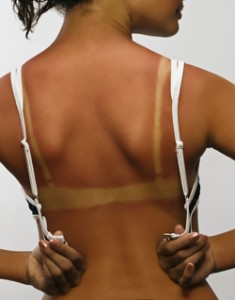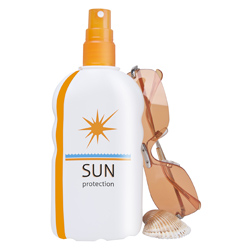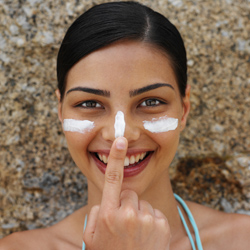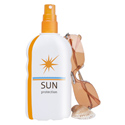Is an SPF of 100 better than 50? What do the terms waterproof, water resistant, and broad spectrum really mean? If you are confused you are not alone. After a lot of arm wrestling back and forth, the FDA finalized its new sunscreen guidelines for consumers. Hopefully the simplification of these terms will dispel some of the confusion-at least a little.
The first sunscreen was developed for the troops in the South Pacific during WWII. It was a red sticky substance called “Red Vet Pet”, or red veterinary petrolatum. Based off the name alone, it’s not hard to understand why so many veterans developed skin cancer later in life.

The marketing gurus at Coppertone acquired the formula, and by renaming it, had their day in the sun. Since the days of Red Vet Pet, the sunscreen industry has blossomed into a billion dollar industry. Technology, science, and manufacturing processes have outpaced our government’s ability to regulate sunscreens effectively. The new guidelines, while far from perfect, are a welcomed step in the right direction.
There are three forms of ultraviolet light from the sun: UVA, UVB, and UVC. The ozone layer over North America still filters out most of the UVC luckily, as it is the most carcinogenic of the three. Both UVA and UVB also induce skin cancers and DNA damage and pass right through the atmosphere. UVB is associated more with inducing sunburn and the whole concept of SPF is based upon blocking UVB only. Wonderful molecular mechanisms of how UVB induced DNA damage and consequently skin cancers have been elucidated for the last few decades. UVA, while known to cause wrinkles and premature aging, confounded researchers and still has not given up all of its secrets.
As bizarre as it sounds, some of the first work done with UVA and melanoma was in fish. A 1993 study concluded that UVA was responsible for melanoma development in a form of fish called swordtails. Thus, I was taught dogmatically in medical school that UVA caused melanoma based upon this animal model. Just this year, that belief was overturned by the MD Anderson Cancer Center in Houston.
So much for what I thought I knew. While nobody believes UVA is “safe” radiation (except the tanning industry), it evidently does not tinker with your DNA like UVB is fond of doing. UVA’s role is well established in causing other types of skin cancer, wrinkles, sun spots, and even suppressing the immune system in the skin.
SPF only refers to UVB protection. (Please read that sentence again. It is important.) Thus an SPF of 100 or even 10,000 offers zero protection from UVA. It is amazing that the FDA and sunscreen industry have chosen to quantify only one of the two cancer causing forms of sunlight.
Just like in the research field, UVA is the problem child here as well. Many of the strong UVA filters are not stable by themselves and have to be mixed with other chemicals that can raise the price of the sunscreen substantially. Helioplex and mexoryl are two words to look for when shopping for good UVA protection. I like to keep it simple and stick with zinc and titanium formulations that give good UVB and UVA coverage. These are usually cheaper and don’t look like diaper paste on your nose any longer (recall the circa 1980’s lifeguard).
New FDA guidelines will allow a sunscreen to be labeled “Broad Spectrum” if it meets strict criteria for UVA/UVB protection. An SPF can also be listed. If the SPF is over 15, the label may state that the product “reduces the risk of skin cancer and early skin aging”. Non-Broad Spectrum sunscreens and Broad Spectrum sunscreens with an SPF value between 2 and 14 can only claim to help prevent sunburn. Confused yet?

Stock up on those “SPF 100” bottles, as they soon will be potential collector items. Under the new guidelines, the SPF can top out at a max of “50+” on the label. Gone will be the days of deliberating between the expensive designer bottle of SPF 100 and the cheaper SPF 30.
Is one really better than the other? Considering an SPF of 15 blocks about 94% of UVB rays and an SPF of 30 blocks only an additional 3% of UVB, one can quickly see there is a law of diminishing returns at work. If you are really wringing your hands over trying to block 94% vs. 97% of the UVB rays, you should probably not be out in the sun to start with. Australia, which has been gripped in a skin cancer epidemic dwarfing ours, caps their SPF labels at “30+”. The sunscreen industry counters with the argument that higher SPF’s are necessary because people do not apply the recommended amount. While I think this is a true statement, I hold concerns that a higher SPF applied improperly would lead to a false sense of security. It is an argument that goes both ways and I am happy the FDA stepped in to legislate this.
The official standard to cover the average adult in sunscreen properly is 2mg/cm2 or 2 tablespoons. People give me a blank look when I tell them that. So instead I recommend the amount a shot glass could contain. This seems to resonate better with people. Sunscreen ideally should be applied about 20 minutes before exposure and every 2 hours after or as activity dictates. Manufactures will longer be able to claim a product is “waterproof” or “sweat proof”, or even call it a “sun block” anymore. “Water resistant” is the new favored term; and two times frames will be allowed to be listed: 40 minutes and 80 minutes. Of course those numbers mean 40 and 80 minutes of standing absolutely motionless in the water and not reflective of normal human aquatic activity. I will still reapply at much sooner intervals, regardless of what the government and Big Industry put on my sunscreen label.
How effective will the new label be when Joe Six Pack goes to choose between sunscreens now? I think we could go farther and just have a series of progressively darker colored bottles to indicate the level of protection rather than all the “Broad Spectrum” and SPF jibber jabber. But that may discriminate against some colorblind people, so it would never fly.
We are in the midst of a skin cancer epidemic with no end in sight. A frightening stat is that one American every hour dies of melanoma. While most skin cancers are not life threatening, they can necessitate extensive surgery and cause deformities that need surgical correction. Luckily, the North State enjoys a crack collection of dermatologists and surgeons skilled in these arts. However melanoma is a different story. While almost 100% curable if caught early, melanoma has a dismal survival rate once it spreads. Despite a few experimental drugs that have grabbed headlines recently, we really are not any

better off treating widespread melanoma than we were forty years ago. My wife pokes fun at the suit of “aboriginal war paint” zinc oxide I slather on my body when we go to Whiskeytown Lake. But when you spend your life cutting out skin cancers on people, one can get a little paranoid. I don’t mind sporting the chalky look at the beach. Let the masses laugh; I’ll be seeing them soon.
Vita carries a dermatology-approved line of sun screen products, including a 30SPF anti-oxidant and a 30SPF oil-free moisturizing.

